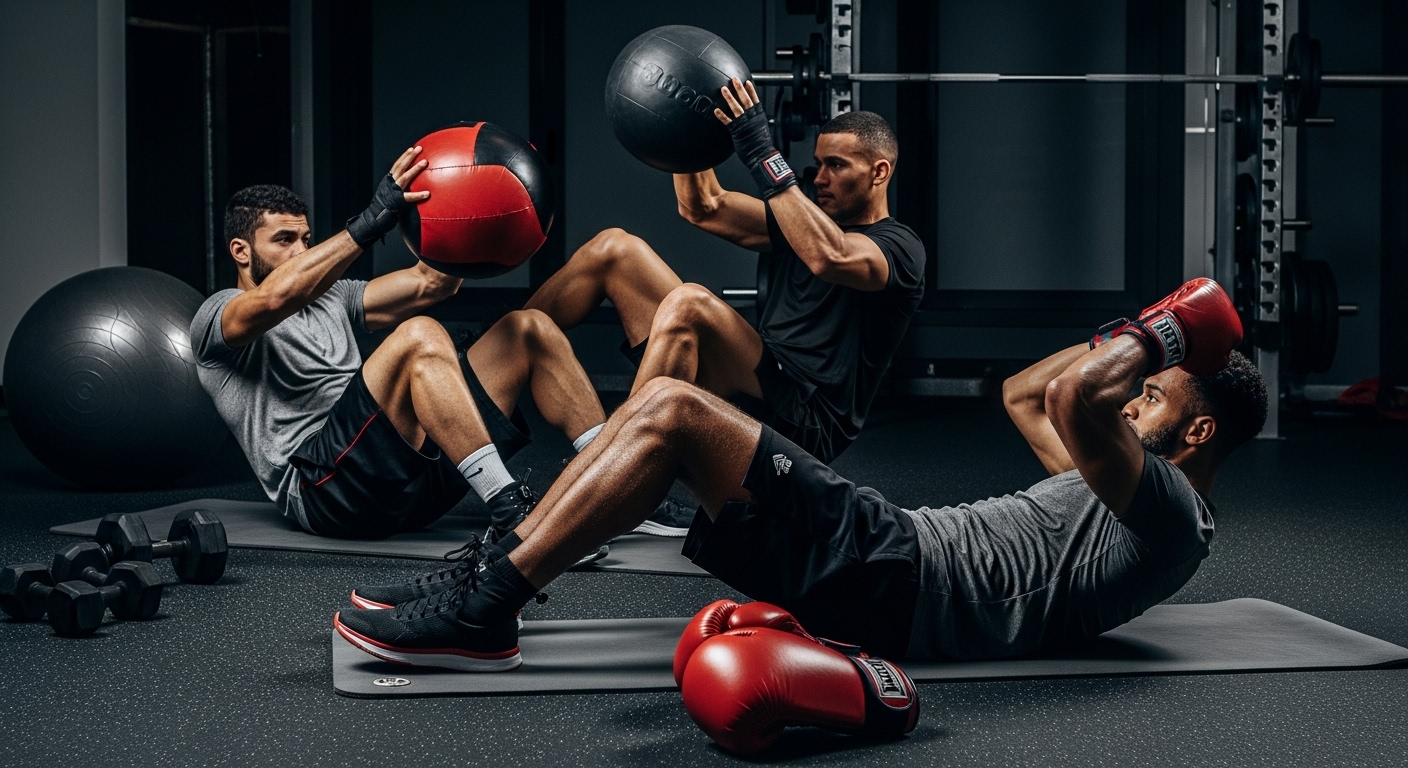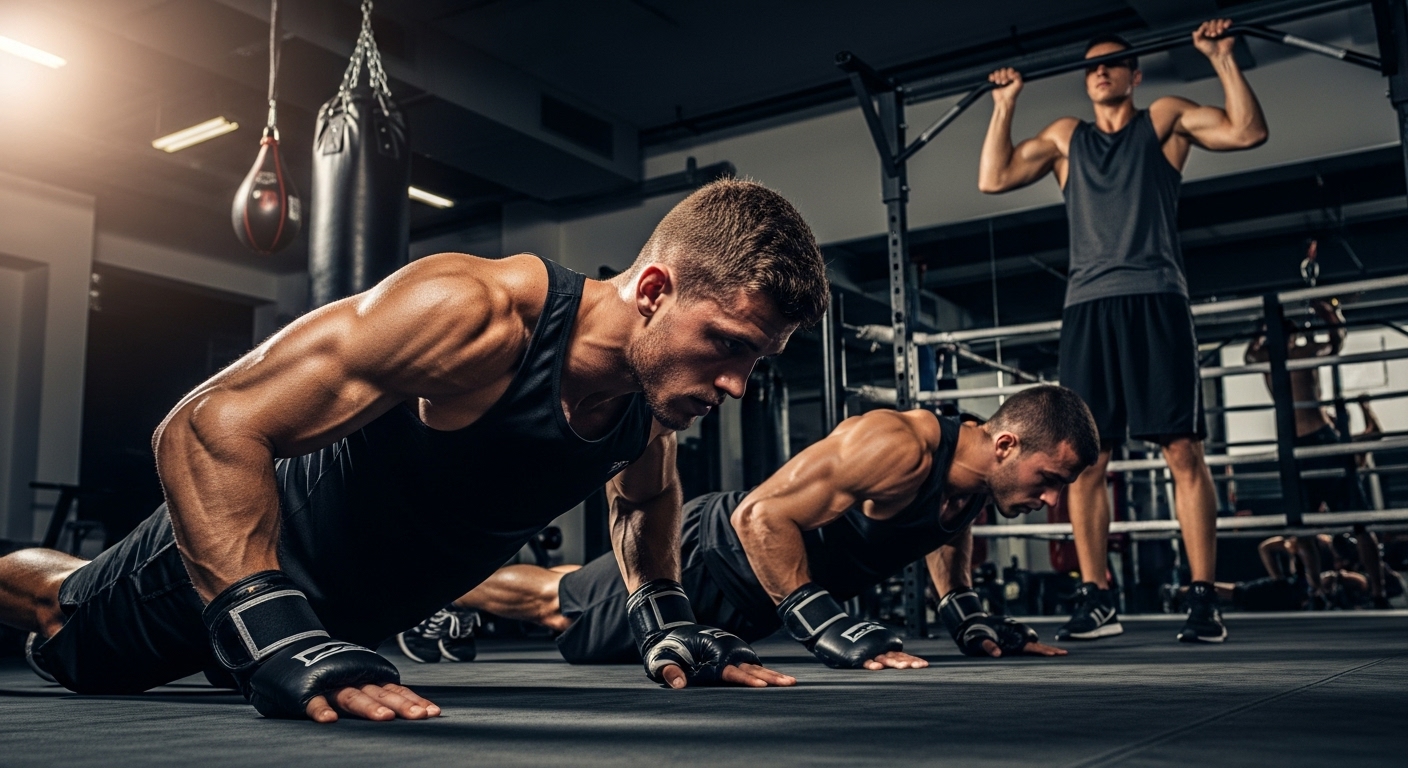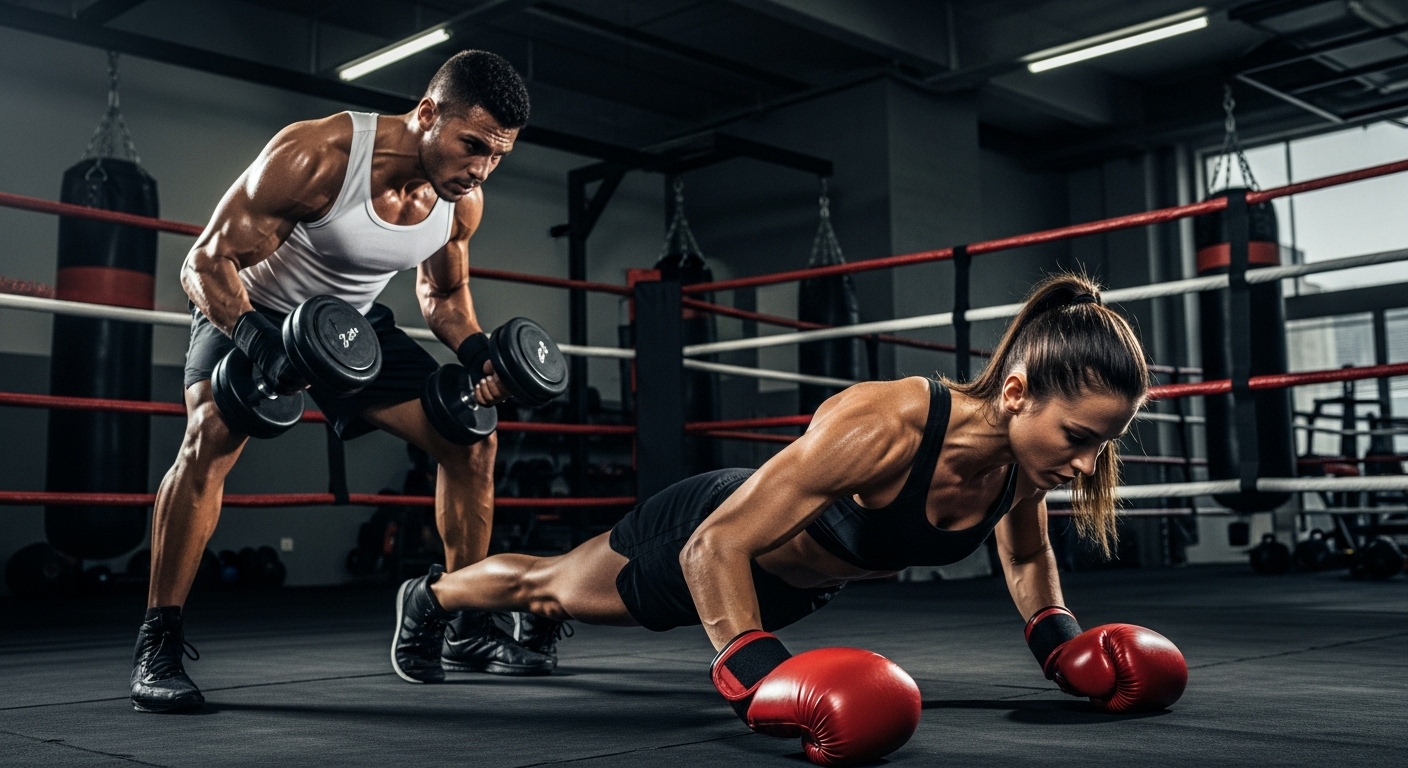Can specific strength training exercises improve a boxer’s performance? The answer is yes, but only if they understand the value of boxing training beyond just punching bags and sparring.
To excel in the ring, boxers must build muscle and increase their speed. We’ll look at key exercises every boxer should do to boost their performance.
By adding these exercises to their boxing workouts, boxers can enhance their skills and gain an edge over their opponents.
Key Takeaways
- Essential strength training exercises for boxers
- Importance of building muscle and boosting speed
- Effective boxing training techniques
- Improving performance in the ring
- Gaining a competitive edge through specific exercises
Why Strength Training Matters for Boxing Performance
Strength training is key in boxing. It boosts a fighter’s performance. It’s not just about building muscle. It’s about increasing power, speed, and endurance.
The Science Behind Power Generation in Boxing
Boxing power comes from moving force from the legs to the arms. This needs muscles in the legs, core, and arms working together. Efficient punch combinations depend on this teamwork. So, strength training is vital for stronger punches.
Balancing Strength and Speed for Optimal Performance
Strength is needed for strong punches, but speed is key for quick punches. A mix of strength and speed training is essential. It helps boxers master boxing techniques. This balance is key for top performance in the ring.
| Training Component | Benefit to Boxing |
|---|---|
| Strength Training | Enhances punching power and endurance |
| Speed Drills | Improves reaction time and punching speed |
| Core Training | Stabilizes the body for better punch combinations |
Essential Core Boxing Workouts for Power
A strong core is key for a boxer’s power. Specific workouts can boost performance. Core strength helps with power, balance, and boxing technique.
Rotational Core Movements for Punch Power
Rotational movements are key for punch power. Exercises that boost rotational strength help boxers throw stronger punches.
Medicine Ball Rotations
Medicine ball rotations are great for rotational strength. They target core muscles for more power in punches.
Russian Twists
Russian twists also focus on rotational strength. They strengthen muscles for twisting, boosting punch power.
Stability Exercises for Better Balance
Stability exercises are vital for balance and core strength. A stable core helps boxers keep their stance and move well in the ring.
Planks and Side Planks
Planks and side planks are key for core stability. They strengthen spine-supporting muscles and improve balance.
Stability Ball Training
Stability ball training works the core for better stability and balance. It’s a great way to boost core strength and endurance.
Progressive Core Training for Boxing Techniques
Progressive core training increases workout intensity to improve strength and technique. It’s essential for mastering boxing techniques and handling training demands.

Upper Body Strength Exercises for Powerful Punches
Having strong upper body muscles is key for good boxing. A strong upper body lets boxers throw strong punches and take hits. It also helps them stay strong during fights.
Push Exercises for Straight Punches and Jabs
Push exercises are important for straight punches and jabs. They work the chest, shoulders, and triceps. These muscles are key for boxing power.
Boxing-Specific Push-Ups
Boxing-specific push-ups focus on boxing muscles. They use different grips and depths. This boosts punching power and endurance.
Bench Press Variations
Bench press variations like incline and decline presses work the chest and shoulders. They help build upper body strength. This makes punches more effective.
Pull Movements for Hook and Uppercut Strength
Pull movements are key for hooks and uppercuts. They work the back, shoulders, and arms. This improves punching technique.
Pull-Ups and Chin-Ups
Pull-ups and chin-ups strengthen the back and arms. A strong back means more powerful hooks and uppercuts.
Rowing Exercises
Rowing exercises work the back, improving posture and punch power. Different rowing styles target different muscles.
Shoulder Conditioning for Punch Endurance and Speed Bag Workout
Shoulder conditioning is vital for punch endurance and boxing performance. Speed bag workouts improve shoulder stability and endurance.
According to renowned boxing coach,
“The speed bag is one of the most underrated tools in boxing training. It improves hand-eye coordination, timing, and shoulder endurance.”
Let’s look at how these exercises compare:
| Exercise | Primary Muscle Group | Benefit |
|---|---|---|
| Push-Ups | Chest, Shoulders, Triceps | Improved Straight Punches |
| Pull-Ups | Back, Shoulders, Arms | Enhanced Hook and Uppercut Strength |
| Speed Bag Workout | Shoulders, Arms | Increased Punch Endurance |

Boxers can boost their punching power and performance with these exercises. Adding heavy bag drills can improve technique and endurance even more.
Lower Body Strength for Boxing Footwork and Power
Boxers need strong legs for quick footwork and strong punches. We must focus on exercises that boost our explosive power, agility, and endurance. This helps us outmaneuver opponents in the ring.
Explosive Leg Exercises for Quick Movement
Explosive leg exercises are key for boxers to move fast in the ring. They help us build the power to quickly change direction and speed up.
Squat Variations
Squats, like back squats and front squats, strengthen our legs. Adding different squats to our routine targets various muscles. This boosts our lower body strength.
Lunges and Split Squats
Lunges and split squats also strengthen our legs. They improve balance and coordination. These exercises help us stay stable and generate power from our lower body.
Hip Strength for Rotational Power in Punch Combinations
Hip strength is key for powerful punches. Strengthening our hips lets us rotate our torso better. This means our punches pack more punch.
Working our hip flexors with leg press and hip thrusts builds punch-driving strength.
Ankle and Calf Training for Advanced Footwork
Ankle and calf training is often ignored but is vital for advanced footwork. Strengthening these areas boosts agility, balance, and footwork.
Doing calf raises and ankle circles strengthens and flexes our ankles and calves. This helps us move fast and stay balanced in the ring.
Heavy Bag Drills and Compound Movements for Boxing Training
To boost our boxing skills, we use heavy bag drills and compound movements. These help us get stronger, last longer, and improve our technique. This makes us better fighters in the ring.
Full-Body Exercises for Boxing-Specific Strength
Full-body exercises are key for building boxing strength and power. They work many muscles at once, just like in boxing.
- Compound Movements: Deadlifts and kettlebell swings work many joints and muscles. This boosts our overall strength.
- Functional Strength: These exercises make us stronger for real-life boxing moves. We can punch harder and move better.
Deadlifts for Boxing Power
Deadlifts target many muscles, like legs, back, and core. Strengthening these areas lets us punch with more power.
Kettlebell Swings and Cleans
Kettlebell swings and cleans build explosive strength and coordination. They’re great for the hip and lower back muscles, key for punch power.
Plyometric Training for Explosive Power
Plyometric training boosts our power and speed with explosive moves. It’s vital for boxers, helping us throw quick and strong punches.
- Box Jumps and Depth Jumps: These exercises boost our explosive power in the legs. We can move fast around the ring.
- Medicine Ball Throws: This exercise strengthens our core and boosts power from our center.
Box Jumps and Depth Jumps
Box jumps and depth jumps increase our explosive power. Adding these to our training improves our footwork and reaction time.
Medicine Ball Throws
Medicine ball throws work our core, shoulders, and arms. They enhance our rotational power and punch strength.
Shadow Boxing with Resistance for Functional Strength
Shadow boxing with resistance bands improves our technique and builds functional strength. The added resistance boosts our endurance and punch power.
- Improved Technique: Shadow boxing sharpens our technique, keeping our form right during fights.
- Functional Strength: The resistance makes our punches more effective, adding to our functional strength.
Conclusion: Implementing Strength Training into Your Boxing Regimen
Strength training is key to improving in boxing. It helps us work on our core, upper body, lower body, and overall strength. This way, we can get better at our boxing skills and training.
Boxing isn’t just about technique. It also needs a strong body for power, speed, and endurance. By doing the strength training exercises we talked about, we can get better at punching and moving around the ring.
A good boxing training plan should include strength training. This helps us reach our goals, whether for a competition or just to stay fit. By focusing on strength, power, and agility, we can improve our boxing and enjoy it more.
